Kingdom of Aksum
The Kingdom of Aksum (Ge'ez: መንግሥተ አኵስም, Sabaic: 𐩱𐩫𐩪𐩣, Ancient Greek: Ἀξωμίτης), also known as the Kingdom of Axum, the City-State of Axum, or the Aksumite Empire, was a kingdom in East Africa and South Arabia from Classical antiquity to the Middle Ages. Based in what is now Northern Ethiopia and Eritrea, and spanning present day Djibouti and Sudan, it extended at its height into much of Southern Arabia during the reign of Kaleb, King of Aksum.
Kingdom of Aksum | |||||||||||||
|---|---|---|---|---|---|---|---|---|---|---|---|---|---|
| 150 BC – c. 960 AD | |||||||||||||
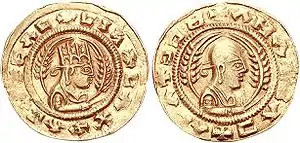 Aksumite currency depicting King Endubis
| |||||||||||||
 Aksum in the 3rd Century before Ezana expansion | |||||||||||||
| Capital |
| ||||||||||||
| Common languages | (from 1st century)[3]
Various[lower-alpha 1] | ||||||||||||
| Religion |
| ||||||||||||
| Demonym(s) | Aksumite, Ethiopian, Abyssinian | ||||||||||||
| Government | Monarchy | ||||||||||||
| Negus/Negusa Nagast | |||||||||||||
• c. 100 | Za Haqala (first known) | ||||||||||||
• c. 940 | Dil Na'od (last) | ||||||||||||
| Historical era | Classical antiquity to Early Middle Ages | ||||||||||||
• Established | 150BC | ||||||||||||
| 3rd century | |||||||||||||
• Conquest of Kush | 330 | ||||||||||||
| 325 or 328 A.D | |||||||||||||
| 520 | |||||||||||||
| 570 | |||||||||||||
| 7th century | |||||||||||||
• Collapse | c. 960 AD | ||||||||||||
| Area | |||||||||||||
| 350[7] | 1,250,000 km2 (480,000 sq mi) | ||||||||||||
| 525 | 250,000 km2 (97,000 sq mi) | ||||||||||||
| Currency | Aksumite currency | ||||||||||||
| |||||||||||||
Axum served as the kingdom's capital for many centuries but relocated to Jarma[8] in the 9th century due to declining trade connections and recurring external invasions.[9][10] Emerging from the earlier Dʿmt civilization, the kingdom was founded in 150BC.[11]It is not known whether a war of succession took place between competing states for control of the region after the fall of D'mt evolved to the Kingdom of Axum.
As the kingdom became a major power on the trade route between Rome and India and gained a monopoly of Indian Ocean trade, it entered the Greco-Roman cultural sphere. Greek was the language of administration in Axum and was widely known by the third century AD. It was used in inscriptions, coinage, and trade.[12][13] The Geʽez script came into use by the 4th century; by the 6th century translations into Ge'ez were common.[13][14] Due to its ties with the Greco-Roman world, the Kingdom of Aksum adopted Christianity as the state religion in the mid-4th century, under Ezana of Axum.[15] Following their Christianization, the Aksumites ceased construction of stelae.[9]
The Kingdom of Aksum was considered one of the four great powers of the 3rd century by the Persian prophet Mani, alongside Persia, Rome, and China.[16] During the reign of Endubis, Aksum began minting coins that have been excavated as far away as Caesarea and southern India.[17] Axum continued to expand under the reign of Gedara, who was the first Axumite king to involve In South Arabian affairs at sometime around the early 3rd century, conquering Najran, the Tihama tribes and occupying the Himyarite capital, Zafar, until a joint Himyarite-Sabean alliance pushed them out. Yemeni-Ethiopian conflicts however will continue throughout the 3rd century.
The kingdom continued to expand throughout late antiquity, conquering Kush under King Ezana in 330 for a short period of time and inheriting from it the Greek exonym "Ethiopia".[18] Aksumite dominance in the Red Sea culminated during the reign of Kaleb of Axum, who, at the behest of the Byzantine Emperor Justin I, invaded the Himyarite Kingdom in Yemen in order to end the persecution of Christians perpetrated by the Jewish king Dhu Nuwas. With the annexation of Himyar, the Kingdom of Aksum was at its largest territorial extent, being around 2,500,000km². However, the territory was lost in the Aksumite–Persian wars.[19]
The kingdom's slow decline had begun by the 7th century, at which point currency ceased to be minted. The Persian (and later Muslim) presence in the Red Sea caused Aksum to suffer economically, and the population of the city of Axum shrank. Alongside environmental and internal factors, this has been suggested as the reason for its decline. Aksum's final three centuries are considered a dark age, and through uncertain circumstances, the kingdom collapsed around 960.[15] Despite its position as one of the foremost empires of late antiquity, the Kingdom of Aksum fell into obscurity as Ethiopia remained isolated throughout the Late Middle Ages.[20]
Etymology
According to some philologists the word “Aksum” derived from a combination of 2 different languages; the Agaw and Ge’ez languages. The word “Ak” (means Water in the Agaw language) and the word “Shum” (means chief/Lord in Ge’ez). However, Carlo Conti Rossini believed that the word Aksum is of Semitic root and means a green and dense garden, full of grass.[21]
History

City-State of Axum
Before the establishment of Axum, the Tigray plateau of northern Ethiopia was home to a kingdom known as Dʿmt. Archaeological evidence shows that the kingdom was influenced by Sabaeans from modern-day Yemen; scholarly consensus had previously been that Sabaeans had been the founders of Semitic civilization in Ethiopia, though this has now been refuted, and their influence is considered to have been minor.[22][lower-alpha 2][23] The Sabaean presence likely lasted only for a matter of decades, but their influence on later Aksumite civilization included the adoption of Ancient South Arabian script, which developed into Geʽez script, and Ancient Semitic religion.[24]
The first historical mention of Axum comes from the Periplus of the Erythraean Sea, a trading guide which likely dates to the mid-1st century AD. Axum is mentioned alongside Adulis and Ptolemais of the Hunts as lying within the realm of Zoskales. The area is described as a primarily producing ivory, as well as tortoise shells. King Zoskales had a Greek education, indicating that Greco-Roman influence was already present at this time.[2] It is evident from the Periplus that, even at this early stage of its history, Axum played a role in the transcontinental trade route between Rome and India.[25]
Axumite Empire
The Kingdom of Axum was a trading empire with its hub in Eritrea and northern Ethiopia.[26] It existed approximately 150 BC–960 AD, growing from the Iron Age proto-Axumite period c. fourth century BC to achieve prominence by the first century AD. According to the Book of Axum, the kingdom's first capital, Mazaber, was built by Itiyopis, son of Cush.[27] The capital was later moved to Axum in northern Ethiopia. The Kingdom used the name "Ethiopia" as early as the fourth century.[22][28]
The Empire of Axum at times extended across most of present-day Eritrea, northern Ethiopia, Western Yemen — which it invaded utilizing the dhow designs of Egypt[29] — and parts of eastern Sudan.[28] The capital city of the empire was Axum, now in northern Ethiopia. Today a smaller community, the city of Axum was once a bustling metropolis, cultural and economic hub. Two hills and two streams lie on the east and west expanses of the city; perhaps providing the initial impetus for settling this area. Along the hills and plain outside the city, the Aksumites had cemeteries with elaborate grave stones called stelee or obelisks. Other important cities included Yeha, Hawulti-Melazo, Matara, Adulis, and Qohaito, the last three of which are now in Eritrea. By the reign of Endubis in the late third century, it had begun minting its own currency and was named by Mani as one of the four great powers of his time along with the Sasanian Empire, Roman Empire, and China. The Axumites adopted Christianity as the state religion in 325 or 328 AD under King Ezana, and Axum was the first state ever to use the image of the cross on its coins.[30][31]
According to the Monumentum Adulitanum, in around the 3rd century (possibly c. 240–c. 260), the Aksumites led by an anonymous king achieved significant territorial expansion in the Ethiopian Highlands and the Arabian Peninsula, with their influence extending as far as Lake Tana and the borders of Egypt.[32][33][34] Around 330, Ezana of Aksum led his army into the Kingdom of Meroë, conquering and sacking the town itself. A large stone monument was left there, and the conquest is also recorded on the Ezana Stone.[35]
Axumite subjugation of Nubia

The Axumite Empire engaged in a invasion that culminated in the capture of the Kushite capital of Meroë in the middle of the 4th century AD, signaling the end of independent Kushite Pagan kingdoms, helping to give rise to Nobatia, Alodia, and Makuria which were established by the Noba Nubians who themselves conquered the kingdom of Kush.[36][37][38]The Axumite presence in Meroe was likely short lived.
Tribal nomads like the Beja, Afar, and Saho managed to remain autonomous due to their uncentralized nomadic nature. These tribal peoples would sporadically inflict attacks and raids on Axumite communities. The Beja nomads eventually Hellenized and integrated into the Nubian Greek society that had already been present in Lower Nubia.[36][37][38]
Kaleb of Axum, Saint Elesbaan


Around 525, King Kaleb sent an expedition against the Jewish Himyarite king Dhu Nuwas, who was persecuting the Christian community there. For nearly half a century south Arabia would become an Axumite protectorate under Abraha and his son Masruq.[39] Dhu Nuwas was deposed and killed and Kaleb appointed a Christian Himyarite, Esimiphaios ("Sumuafa Ashawa"), as his viceroy. However, around 530 this viceroy was deposed by the Aksumite general Abraha with support of Ethiopians who had settled in Yemen. Kaleb sent two expeditions against Abraha, but both were decisively defeated. Kaleb did not pursue the matter further, and recognized Abraha as his new viceroy.[40]
After Abraha's death, his son Masruq Abraha continued the Aksumite vice-royalty in Yemen, resuming payment of tribute to Aksum. However, his half-brother Ma'd-Karib revolted. Ma'd-Karib first sought help from the Roman Emperor Justinian the Great, but having been denied, he decided to ally with the Sassanid Persian Emperor Khosrow I, triggering the Aksumite–Persian wars. Khosrow I sent a small fleet and army under commander Vahrez to depose the king of Yemen. The war culminated with the Siege of Sana'a, capital of Aksumite Yemen. After its fall in 570, and Masruq's death, Ma'd-Karib's son, Saif, was put on the throne.
In 575, the war resumed again, after Saif was killed by Aksumites. The Persian general Vahrez led another army of 8000, ending Axum rule in Yemen and becoming hereditary governor of Yemen. According to Stuart Munro-Hay, these wars may have been Aksum's swan-song as a great power, with an overall weakening of Aksumite authority and over-expenditure in money and manpower.
According to Ethiopian traditions, Kaleb eventually abdicated and retired to a monastery. It is also possible that Axum was affected by the Plague of Justinian around this time.[22]
Rise of Islam
.jpg.webp)
After a second golden age in the early 6th century,[22] Aksum was a strong empire and trading power; however, with the rise of Islam in the early 7th century, Axum began to decline. Axum initially had good relations with its Islamic neighbours. In 615 AD for example, early Muslims from Mecca fleeing Qurayshi persecution traveled to Axum and were given refuge; this journey is known in Islamic history as the First Hijrah.[41][42][43][44] However, in 630, Muhammad sent a naval expedition lead by Umar against the port of Adulis, the Expedition of Alqammah bin Mujazziz, igniting hostile relations.[45]
Eventually, the Rashidun Caliphate took control of the Red Sea and Egypt by 646, pushing Aksum into economic isolation. Northwest of Aksum, in modern-day Sudan, the Christian states of Nobatia, Makuria and Alodia lasted until the 13th century before being overrun by Bedouin tribes and the Funj Sultanate. Aksum, isolated, nonetheless still remained Christian.[22]
Dark Age and decline

The Axumite Empire declined in the mid 7th century as the Islamic powers occupied the trade routes leading to Alexandria and Byzantium,[46] and eventually ceased production of coins in the early 8th century.[47] Around this same time, the Aksumite population was forced to go farther inland to the highlands for protection, abandoning Aksum as the capital. Arab writers of the time continued to describe Ethiopia (no longer referred to as Aksum) as an extensive and powerful state, though they had lost control of most of the coast and their tributaries.
While land was lost in the north, it was gained in the south; and, though Ethiopia was no longer an economic power, it still attracted Arab merchants. The capital was then moved south to a new location called Ku'bar or Jarmi.[22] The Arab writer Ya'qubi was the first to describe the new Aksumite capital. The capital was probably located in southern Tigray or Angot; however, the exact location of this city is currently unknown.[48] Famine is noted in Ethiopia in the ninth century. The patriarchates James (819–830) and Joseph (830–849) of Alexandria attribute Ethiopia's condition to war, plague, and inadequate rains.[49] Under the reign of Degna Djan, during the 9th century, the empire kept expanding south, and sent troops into the modern-day region of Kaffa,[50] while at the same time undertaking missionary activity into Angot.
Queen Gudit's invasion


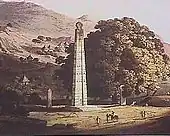
Local history holds that, around 960, a Jewish Queen named Yodit (Judith) or "Gudit" defeated the empire and burned its churches and literature. While there is evidence of churches being burned and an invasion around this time, her existence has been questioned by some western authors. Gudit sacked Aksum by destroying churches and buildings, persecuted Christians and committed Christian iconoclasm. Her origin has been debated among scholars. Some argued that she had a Jewish ethnicity or was from a southern region. According to one traditional account, she reigned for forty years and her dynasty lasted until 1137 AD, when it was overthrown by Mara Takla Haymanot, resulting in the inception of the Agaw-led Zagwe dynasty.
Gudit's origin has been extensively debated. Scholars debate whether she was a Jew, an Agaw, a Beja, and an enslaved servant of an Aksumite emperor who wanted to lead pagans against Christianity. Others argued that she was a daughter of the king of Lasta, situated in Bugna. The Italian scholar Carlo Conti Rossini described her as a Bani al-Hamwiyah, while another source pointed to the Sidama people in the area called Sasu, probably south of the Blue Nile, where Aksumite rulers also obtained caravans for commodities of gold and coin, which are thought the main motive for Gudit's raid.[51]
According to an oral tradition, Gudit rose to power after she killed the Beta Israel emperor and then reigned for 40 years. She brought her Jewish army from Gondar and Lake Tana to orchestrate the pillage against Aksum and its countryside. She was determined to destroy all members of the Aksumite dynasty, palaces, churches and monuments in Tigray. Her notorious deeds are still recounted by peasants inhabiting northern Ethiopia. Large ruins, standing stones and stelae are found in the area.[52]
Around 960,[53] she attacked Aksum, demolishing churches (the Church of Our Lady Mary of Zion was partially demolished), monasteries, buildings and committing Christian iconoclasm. Gudit also killed the last emperor of Aksum, possibly Dil Na'od, while other accounts say Dil Na'od went into exile in Shewa, protected by Christians. He begged assistance from a Nubian Greek ruler, King Moses Georgios, but remained unanswered.[54] She was said to have been succeeded by Dagna-Jan, whose throne name was Anbasa Wudem.[51] Her reign was marked by the displacement of the Aksumite population into the south.
According to one Ethiopian traditional account, she reigned for forty years and her dynasty was eventually overthrown by Mara Tekla Haymanot in 1137 AD, who ushered in the formation of the Zagwe dynasty by bearing children with a descendant of the last Aksumite emperor, Dil Na'od.[55]
Another possibility of decline is that the Aksumite power was ended by a southern pagan queen named Bani al-Hamwiyah, possibly of the tribe al-Damutah or Damoti (Damot). It is clear from contemporary sources that a female usurper did indeed rule the country at this time, and that her reign ended some time before 1003. After a short Dark Age, the Aksumite Empire was succeeded by the Zagwe dynasty in the 11th or 12th century (most likely around 1137), although limited in size and scope. However, Yekuno Amlak, who killed the last Zagwe king and founded the modern Solomonic dynasty around 1270 traced his ancestry and his right to rule from the last emperor of Aksum, Dil Na'od. It should be mentioned that the end of the Aksumite Empire didn't mean the end of Aksumite culture and traditions; for example, the architecture of the Zagwe dynasty at Lalibela and Yemrehana Krestos Church shows heavy Aksumite influence.[22]
Society
The Aksumite population mostly consisted of Semitic-speaking people collectively known as the Habeshas. The Axumite Empire also had a sizeable Ethiopian Greek population, which resided in Axumite cities such as the capital Axum, Ptolemais Theron, the port of Adulis, and inhabited the Tigray Province.[56][57] Other ethnic groups inhabited Axum, and inscriptions from the time of Ezana note the "Barya", an animist tribe who lived in the western part of the empire, believed to be the Naras. The Aksumites were in constant conflict with animist tribes.[58][59][60][61] The Agaw people were also known to have lived in the southern frontiers of the kingdom and were typically employed in the Aksumite army.[62]
Aksumites had a modified feudal system to farm the land.[30][31]
Kings
The Aksumite kings had the official title ንጉሠ ነገሥት nəguśä nägäśt, meaning "king of kings."
Culture
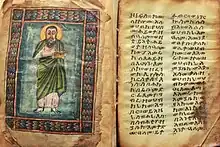
The Empire of Aksum is notable for a number of achievements, such as its own alphabet, the Ge'ez script, which was eventually modified to include vowels, becoming an abugida. Furthermore, in the early times of the empire, around 1700 years ago, giant obelisks to mark emperors' (and nobles') tombs (underground grave chambers) were constructed, the most famous of which is the Obelisk of Aksum.
Under Emperor Ezana, Aksum adopted Coptic Christianity in place of its former polytheistic and Judaic religions around 325. The Axumite Coptic Church gave rise to the present day Ethiopian Orthodox Tewahedo Church (only granted autonomy from the Coptic Church in 1959) and Eritrean Orthodox Tewahdo Church (granted autonomy from the Ethiopian Orthodox church in 1993). Since the schism with Orthodoxy following the Council of Chalcedon (451), it has been an important Miaphysite church, and its scriptures and liturgy continue to be in Ge'ez.[43][44][63]
Religion

Before its conversion to Christianity, the Aksumites practiced a polytheistic religion related to the religion practiced in southern Arabia. This included the use of the crescent-and-disc symbol used in southern Arabia and the northern horn.[64] In the UNESCO sponsored General History of Africa French archaeologist Francis Anfray, suggests that the pagan Aksumites worshipped Astar, his son, Mahrem, and Beher.[65]

Steve Kaplan argues that with Aksumite culture came a major change in religion, with only Astar remaining of the old gods, the others being replaced by what he calls a "triad of indigenous divinities, Mahrem, Beher and Medr." He also suggests that Aksum culture was significantly influenced by Judaism, saying that "The first carriers of Judaism reached Ethiopia between the reign of Queen of Sheba BC and conversion to Christianity of King Ezana in the fourth century AC." He believes that although Ethiopian tradition suggests that these were present in large numbers, that "A relatively small number of texts and individuals dwelling in the cultural, economic, and political center could have had a considerable impact." and that "their influence was diffused throughout Ethiopian culture in its formative period. By the time Christianity took hold in the fourth century, many of the originally Hebraic-Jewish elements had been adopted by much of the indigenous population and were no longer viewed as foreign characteristics. Nor were they perceived as in conflict with the acceptance of Christianity."[66]
Before converting to Christianity, King Ezana II's coins and inscriptions show that he might have worshiped the gods Astar, Beher, Meder/Medr, and Mahrem. Another of Ezana's inscriptions is clearly Christian and refers to "the Father, the Son, and the Holy Spirit".[67] Around 324 AD the King Ezana II was converted to Christianity by his teacher Frumentius, who established the Axumite Coptic Church, which later became the modern Ethiopian Orthodox Church.[68][42][41] Frumentius taught the emperor while he was young, and it is believed that at some point staged the conversion of the empire.[69][70] We know that the Aksumites converted to Christianity because in their coins they replaced the disc and crescent with the cross.
Frumentius was in contact with the Church of Alexandria, and was appointed Bishop of Ethiopia around the year 330. The Church of Alexandria never closely managed the affairs of the churches in Aksum, allowing them to develop their own unique form of Christianity.[30][31] However, the Church of Alexandria probably did retain some influence considering that the churches of Aksum followed the Church of Alexandria into Oriental Orthodoxy by rejecting the Fourth Ecumenical Council of Chalcedon.[71] Aksum is also the alleged home of the holy relic the Ark of the Covenant. The Ark is said to have been placed in the Church of Our Lady Mary of Zion by Menelik I for safekeeping.[43][44]
Islam came in the 7th century at the reign of Ashama ibn-Abjar when the followers of Muhammed were persecuted by the ruling tribe and begun migrating after the first followers got asylum from the King many begun to migrate. All of them returned to Medina in 622.source?
Coinage
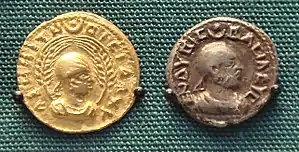
The Empire of Aksum was one of the first African polities to issue its own coins,[69][70] which bore legends in Ge'ez and Greek. From the reign of Endubis up to Armah (approximately 270 to 610), gold, silver and bronze coins were minted. Issuing coinage in ancient times was an act of great importance in itself, for it proclaimed that the Aksumite Empire considered itself equal to its neighbours. Many of the coins are used as signposts about what was happening when they were minted. An example being the addition of the cross to the coin after the conversion of the empire to Christianity. The presence of coins also simplified trade, and was at once a useful instrument of propaganda and a source of profit to the empire.
Architecture
Palace architecture

In general, elite Aksumite buildings such as palaces were constructed atop podia built of loose stones held together with mud-mortar, with carefully cut granite corner blocks which rebated back a few centimeters at regular intervals as the wall got higher, so the walls narrowed as they rose higher. These podia are often all that survive of Aksumite ruins. Above the podia, walls were generally built with alternating layers of loose stone (often whitewashed, like at Yemrehana Krestos Church) and horizontal wooden beams, with smaller round wooden beams set in the stonework often projecting out of the walls (these are called 'monkey heads') on the exterior and sometimes the interior.
Both the podia and the walls above exhibited no long straight stretches but were indented at regular intervals so that any long walls consisted of a series of recesses and salients. This helped to strengthen the walls. Worked granite was used for architectural features including columns, bases, capitals, doors, windows, paving, water spouts (often shaped like lion heads) and so on, as well as enormous flights of stairs that often flanked the walls of palace pavilions on several sides. Doors and windows were usually framed by stone or wooden cross-members, linked at the corners by square 'monkey heads', though simple lintels were also used. Many of these Aksumite features are seen carved into the famous stelae as well as in the later rock hewn churches of Tigray and Lalibela.[22]
Palaces usually consisted of a central pavilion surrounded by subsidiary structures pierced by doors and gates that provided some privacy (see Dungur for an example). The largest of these structures now known is the Ta'akha Maryam, which measured 120 × 80m, though as its pavilion was smaller than others discovered it is likely that others were even larger.[22]
Some clay models of houses survive to give us an idea of what smaller dwellings were like. One depicts a round hut with a conical roof thatched in layers, while another depicts a rectangular house with rectangular doors and windows, a roof supported by beams that end in 'monkey heads', and a parapet and water spout on the roof. Both were found in Hawelti. Another depicts a square house with what appear to be layers of pitched thatch forming the roof.[22]
Stelae
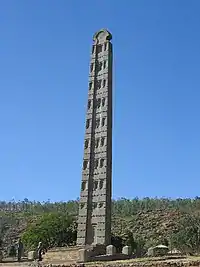
The stelae are perhaps the most identifiable part of the Aksumite architectural legacy. These stone towers served to mark graves and represent a magnificent multi-storied palace. They are decorated with false doors and windows in typical Aksumite design. The largest of these towering obelisks would measure 33 meters high had it not fractured. The stelae have most of their mass out of the ground, but are stabilized by massive underground counter-weights. The stone was often engraved with a pattern or emblem denoting the king's or the noble's rank.[30][31]
For important monuments built in the region, a particular type of granite is used called nepheline syenite. It is fine grained and has also been used in historic monuments like the Stelae. These monuments are used to celebrate key figures in Axum history, especially kings or priests. These Stelae’s are also called “Obelisk’s,” they are located in the Mai Hejja stelae field, where complex sedimentology of the land can be observed. The foundations for the monuments are around 8.5 m below the surface of the Mai Hejja stelae field. Sediments in this area have undergone a lot of weathering over the years, so the surface of this area has undergone a lot of changes. This is part of the reason for the complex stratigraphic history in this site, some previous layers under the surface of the site.[72]
Foreign relations, trade, and economy

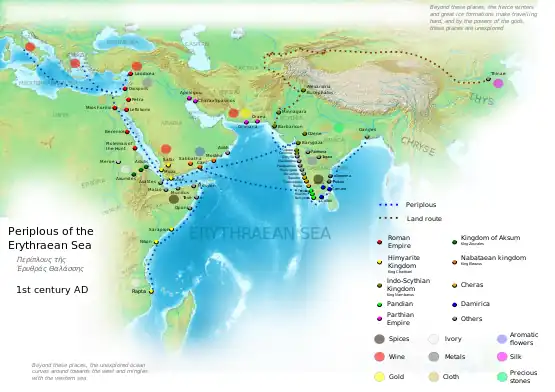
Covering parts of what is now northern Ethiopia and southern and eastern Eritrea, Aksum was deeply involved in the trade network between the Indian subcontinent and the Mediterranean (Rome, later Byzantium), exporting ivory, tortoise shell, gold and emeralds, and importing silk and spices.[43][44] Aksum's access to both the Red Sea and the Upper Nile enabled its strong navy to profit in trade between various African (Nubia), Arabian (Yemen), and Indian states.
The main exports of Aksum were, as would be expected of a state during this time, agricultural products. The land was much more fertile during the time of the Aksumites than now, and their principal crops were grains such as wheat, barley and teff. The people of Aksum also raised cattle, sheep, and camels. Wild animals were also hunted for things such as ivory and rhinoceros horns. They traded with Roman traders as well as with Egyptian and Persian merchants. The empire was also rich with gold and iron deposits. These metals were valuable to trade, but another mineral was also widely traded: salt. Salt was abundant in Aksum and was traded quite frequently.[42][41]
It benefited from a major transformation of the maritime trading system that linked the Roman Empire and India. This change took place around the start of the 1st century. The older trading system involved coastal sailing and many intermediary ports. The Red Sea was of secondary importance to the Persian Gulf and overland connections to the Levant. Starting around 100 BC a route from Egypt to India was established, making use of the Red Sea and using monsoon winds to cross the Arabian Sea directly to southern India. By about 100 AD, the volume of traffic being shipped on this route had eclipsed older routes. Roman demand for goods from southern India increased dramatically, resulting in greater number of large ships sailing down the Red Sea from Roman Egypt to the Arabian Sea and India.[69][70]
In 525 CE, the Askumites attempted to take over the Yemen region to gain control over The Straits of Bab-el-Mandeb; one of the most significant trading routes in the medieval world, connecting the Red Sea to the Indian Ocean. Rulers were inclined to establish a spot of imperialism across the Red Sea in Yemen to completely control the trading vessels that ran down the Straits of Bab-el-Mandeb. It is located in the maritime choke point between Yemen and Djibouti and Eritrea. Because of the ruler of Yemen’s persecution of Christians in 523 CE, Kaleb I, the ruler of Askum (a Christian region) at the time, responded to the persecutions by attacking Yemen in 525 CE, with the help of the Byzantine empire, with whom had ties with his kingdom. Victoriously, the Askum empire was able to claim the Yemen region, establishing a viceroy in the region and troops to defend it until 570 CE when the Sassanids invaded.
The Kingdom of Aksum was ideally located to take advantage of the new trading situation. Adulis soon became the main port for the export of African goods, such as ivory, incense, gold, slaves, and exotic animals. In order to supply such goods the kings of Aksum worked to develop and expand an inland trading network. A rival, and much older trading network that tapped the same interior region of Africa was that of the Kingdom of Kush, which had long supplied Egypt with African goods via the Nile corridor. By the 1st century AD, however, Aksum had gained control over territory previously Kushite. The Periplus of the Erythraean Sea explicitly describes how ivory collected in Kushite territory was being exported through the port of Adulis instead of being taken to Meroë, the capital of Kush. During the 2nd and 3rd centuries AD the Kingdom of Aksum continued to expand their control of the southern Red Sea basin. A caravan route to Egypt was established which bypassed the Nile corridor entirely. Aksum succeeded in becoming the principal supplier of African goods to the Roman Empire, not least as a result of the transformed Indian Ocean trading system.[73]
Climate change hypothesis
%252C_stele_axumita_06.JPG.webp)
Climatic change and trade isolation have also been claimed as large reasons for the decline of the culture. The local subsistence base was substantially augmented by a climatic shift during the 1st century AD that reinforced the spring rains, extended the rainy season from 3 1/2 to six or seven months, vastly improved the surface and subsurface water supply, doubled the length of the growing season, and created an environment comparable to that of modern central Ethiopia (where two crops can be grown per annum without the aid of irrigation).
Askum was also located on a plateau 6,562 feet above sea level, making its soil fertile and the land good for agriculture. This appears to explain how one of the marginal agricultural environments of Ethiopia was able to support the demographic base that made this far flung commercial empire possible. It may also explain why no Aksumite rural settlement expansion into the moister, more fertile, and naturally productive lands of Begemder or Lasta can be verified during the heyday of Aksumite power.
As international profits from the exchange network declined, Aksum lost its ability to control its own raw material sources and that network collapsed. The already persistent environmental pressure of a large population to maintain a high level of regional food production had to be intensified. The result was a wave of soil erosion that began on a local scale c. 650 and attained catastrophic proportions after 700. Presumably complex socio-economic inputs compounded the problem. These are traditionally reflected in declining maintenance, deterioration and partial abandonment of marginal crop land, shifts to destructive pastoral exploitation, and eventual, wholesale and irreversible land degradation. This syndrome was possibly accelerated by an apparent decline in rainfall reliability beginning 730–760, with the presumed result that an abbreviated modern growing season was reestablished during the 9th century.[74]: 495
In literature
The Aksumite Empire is portrayed as the main ally of Byzantium in the Belisarius series by David Drake and Eric Flint published by Baen Books. The series takes place during the reign of Kaleb, who in the series was assassinated by the Malwa in 532 at the Ta'akha Maryam and succeeded by his youngest son Eon bisi Dakuen.
In the Elizabeth Wein series The Lion Hunters, Mordred and his family take refuge in Aksum after the fall of Camelot. Kaleb is the ruler in the first book; he passes his sovereignty onto his son Gebre Meskal, who rules during the Plague of Justinian.
Gallery
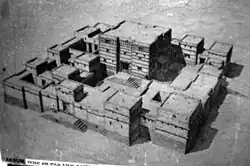 Reconstruction of Dungur
Reconstruction of Dungur.jpg.webp) The largest Aksumite stele, broken where it fell.
The largest Aksumite stele, broken where it fell.
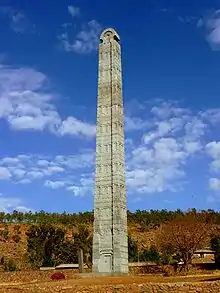 The Obelisk of Aksum after being returned to Ethiopia.
The Obelisk of Aksum after being returned to Ethiopia..jpg.webp) Model of the Ta'akha Maryam palace.
Model of the Ta'akha Maryam palace..jpg.webp) Aksumite water-spouts in the shape of lion heads.
Aksumite water-spouts in the shape of lion heads..jpg.webp) Aksumite jar with figural spout.
Aksumite jar with figural spout. Tombs beneath the stele field.
Tombs beneath the stele field. Entrance to the Tomb Of The False Door.
Entrance to the Tomb Of The False Door. The Stelae Park in Aksum.
The Stelae Park in Aksum. Small stelae in the Gudit Stelae Field
Small stelae in the Gudit Stelae Field.jpg.webp) Another stelae field in Aksum.
Another stelae field in Aksum. Istifanos Monastery in Hayk.
Istifanos Monastery in Hayk. Aksumite gold coins.
Aksumite gold coins. Aksum stelle and ruins
Aksum stelle and ruins Aksum stelle in desert
Aksum stelle in desert
Notes
- Latin, Arabic, Coptic Egyptian, Persian, Nubian, and other languages.[4]
- According to Munro-Hay, "The arrival of Sabaean influences does not represent the beginning of Ethiopian civilisation.... Semiticized Agaw peoples are thought to have migrated from south-eastern Eritrea possibly as early as 2000 BC, bringing their 'proto-Ethiopic' language, ancestor of Ge'ez and the other Ethiopian Semitic languages, with them; and these and other groups had already developed specific cultural and linguistic identities by the time any Sabaean influences arrived."[22]
References
- Donald Fairbairn (2021). The Global Church---The First Eight Centuries From Pentecost Through the Rise of Islam. Zondervan Academic. p. 146.
- "The Periplus of the Erythraean Sea: Travel and Trade in the Indian Ocean by a Merchant of the First Century". Fordham University Internet History Sourcebooks, chapters 4 and 5.
- "Snowden Lectures: Stanley Burstein, When Greek was an African Language". The Center for Hellenic Studies. 2 November 2020. Retrieved 23 February 2022.
- Molefi Kete Asante (2013). The African American People A Global History. Taylor & Francis. p. 13.
- Vincent Khapoya (2015). The African Experience. Routledge. p. 71.
- Turchin, Peter and Jonathan M. Adams and Thomas D. Hall: "East-West Orientation of Historical Empires and Modern States", p. 222. Journal of World-Systems Research, Vol. XII, No. II, 2006
- Turchin, Peter; Adams, Jonathan M.; Hall, Thomas D. (December 2006). "East-West Orientation of Historical Empires" (PDF). Journal of World-Systems Research. 12 (2): 222. ISSN 1076-156X. Archived (PDF) from the original on 7 July 2020. Retrieved 5 June 2023.
- Burstein, Stanley (2015), Benjamin, Craig (ed.), "Africa: states, empires, and connections", The Cambridge World History: Volume 4: A World with States, Empires and Networks 1200 BCE–900 CE, The Cambridge World History, Cambridge: Cambridge University Press, vol. 4, pp. 631–661, ISBN 978-1-139-05925-1, retrieved 19 February 2022
- Phillipson, David W. (2012). Foundations of an African Civilisation: Aksum & the Northern Horn, 1000 BC - AD 1300. Woodbridge: James Currey. p. 48. ISBN 978-1-84701-041-4.
- Butzer, Karl W. (1981). "Rise and Fall of Axum, Ethiopia: A Geo-Archaeological Interpretation". American Antiquity. Cambridge University Press. 46 (3): 471–495. doi:10.2307/280596. JSTOR 280596. S2CID 162374800.
- Munro-Hay, Stuart (1991). Aksum: An African Civilisation of Late Antiquity. Edinburgh: Edinburgh University Press. p. 69. ISBN 0748601066.
- American Numismatic Society (1984). Museum Notes, Volumes 29 to 31. American Numismatic Society. p. 165.
- Judith S. McKenzie; Francis Watson (2016). The Garima Gospels: Early Illuminated Gospel Books from Ethiopia. NYU Press. p. 18.
- Munro-Hay, Stuart (1991). Aksum: An African Civilisation of Late Antiquity. Edinburgh: Edinburgh University Press. p. 5. ISBN 0748601066.
- Derat, Marie-Laure (2020). "Before the Solomonids: Crisis, Renaissance and the Emergence of the Zagwe Dynasty (Seventh–Thirteenth Centuries)". In Kelly, Samantha (ed.). A Companion to Medieval Ethiopia and Eritrea. Leiden: Brill. p. 34. ISBN 978-90-04-41958-2.
- Munro-Hay, Stuart (1991). Aksum: An African Civilisation of Late Antiquity. Edinburgh: Edinburgh University Press. p. 17. ISBN 0748601066.
- Hahn, Wolfgang (2000). "Askumite Numismatics - A critical survey of recent Research". Revue Numismatique. 6 (155): 281–311. doi:10.3406/numi.2000.2289. Retrieved 9 September 2021.
- Munro-Hay, Stuart (1991). Aksum: An African Civilisation of Late Antiquity. Edinburgh: Edinburgh University Press. pp. 15–16. ISBN 0748601066.
- Munro-Hay, Stuart (1991). Aksum: An African Civilisation of Late Antiquity. Edinburgh: Edinburgh University Press. p. 55. ISBN 0748601066.
- Fritsch, Emmanuel; Kidane, Habtemichael (2020). "The Medieval Ethiopian Orthodox Church and Its Liturgy". In Kelly, Samantha (ed.). A Companion to Medieval Ethiopia and Eritrea. Leiden: Brill. p. 169. ISBN 978-90-04-41958-2.
- Selassie, Sergew Hable (1972). Ancient and Medieval Ethiopian History to 1270. p. 68.
- Munro-Hay, Stuart (1991). Aksum: An African Civilization of Late Antiquity (PDF). Edinburgh: University Press. p. 57. Archived from the original (PDF) on 23 January 2013. Retrieved 1 February 2013.
- Pankhurst, Richard K. P. (17 January 2003). "Let's Look Across the Red Sea I". Addis Tribune. Archived from the original on 9 January 2006. Retrieved 1 February 2013.
- Munro-Hay, Stuart (1991). Aksum: An African Civilisation of Late Antiquity. Edinburgh: Edinburgh University Press. pp. 61–62. ISBN 0748601066.
- Phillips, Jacke (2016). "Aksum, Kingdom of". In MacKenzie, John M. (ed.). The Encyclopedia of Empire. Hoboken: John Wiley & Sons, Ltd. pp. 1–2. ISBN 9781118455074.
- Phillipson, David (2012). Neil Asher Silberman (ed.). The Oxford Companion to Archaeology. Oxford University Press. p. 48. ISBN 978-0-19-973578-5.
- Africa Geoscience Review. Rock View International. 1 January 2003. p. 366.
- Henze, Paul B. (2005) Layers of Time: A History of Ethiopia, ISBN 1-85065-522-7.
- Syvänne, Ilkka (9 September 2015). Military History of Late Rome, 284–361. Pen and Sword. ISBN 978-1-4738-7183-0.
- Archived copy ufl.edu Archived 2018-03-29 at the Wayback Machine
- "Aksum".
- George Hatke, Aksum and Nubia: Warfare, Commerce, and Political Fictions in Ancient Northeast Africa (New York University Press, 2013), pp. 44. ISBN 0-7486-0106-6
- Thonemann, Peter (2013), "Phrygia: an anarchist history, 950 BC–AD 100", in Thonemann, Peter (ed.), Roman Phrygia, Cambridge University Press, pp. 1–40, doi:10.1017/cbo9781139381574.002, ISBN 978-1-139-38157-4
- "The Christian Topography of Cosmas Indicopleustes". Nature. 84 (2127): 133–134. August 1910. Bibcode:1910Natur..84..133.. doi:10.1038/084133a0. hdl:2027/coo1.ark:/13960/t07w6zm1b. ISSN 0028-0836. S2CID 3942233.
- Stanley M. Burstein, "Axum and the Fall of Meroe, Journal of the American Research Center in Egypt Vol. 18 (1981), pp. 47–50
- Mohammad Ali (1996). Ethnicity, Politics, and Society in Northeast Africa Conflict and Social Change. University Press of America. p. 119.
- M Honegger (2018). Nubian Archaeology in the XXIst Century Proceedings of the Thirteenth International Conference for Nubian Studies, Neuchatel, 1st-6th September 2014. Peeters Publishers. p. 586.
- Gawdat Gabra; Hany Takla (2013). Christianity and Monasticism in Aswan and Nubia. American University in Cairo Press. p. 352.
- electricpulp.com. "ABNĀʾ – Encyclopaedia Iranica". www.iranicaonline.org. Retrieved 13 April 2018.
- Bury, J. B. (1923). History of the Later Roman Empire. Vol. II. Macmillan & Co. pp. 325–326.
- Bekerie, Ayele. "The Rise of the Askum Obelisk is the Rise of Ethiopian History" (PDF). Newark, USA: Rutgers University. Archived from the original (PDF) on 7 January 2017. Retrieved 6 January 2017.
- "GoBlues - Asheville School" (PDF). 16 May 2023.
- The British Museum; The CarAf Centre. "The wealth of Africa – The kingdom of Aksum: Teachers' notes" (PDF). BritishMuseum.org. Archived from the original (PDF) on 4 November 2019.
- "Daily Life in Aksum" (PDF). www.hmhco.com/ (formerly eduplace.com). Research Reports: Daily Life in Ancient Times. Houghton Mifflin Company. Archived from the original (PDF) on 3 August 2020.
- E. Cerulli, "Ethiopia's Relations with the Muslim World" in Cambridge History of Africa: Africa from the Seventh to the Eleventh century, p. 575; Trimingham, Spencer, Islam in Ethiopia, p. 46.
- David W. Phillipson (2012): Foundations of an African Civilisation: Aksum and the Northern Horn, 1000 BC – AD 1300. James Currey. p. 209
- Daniel Don Nanjira (2010). African Foreign Policy and Diplomacy from Antiquity to the 21st Century, Volume 1. ABC-CLIO. p. 85.
- Taddesse Tamrat, Church and State in Ethiopia (Oxford: Clarendon Press, 1972), p. 36.
- Evetts, B.: "History of the Patriarchs of the Coptic Church of Alexandria", by Sawirus ibn al-Mukaffa', bishop of al-Ashmunien, Vol I, IV, Menas I to Joseph, PO X fasc. 5. pp 375-551, Paris, 1904
- Werner J. Lange, ”History of the Southern Gonga (southwestern Ethiopia)“, Steiner, 1982, p. 18
- Henze, Paul B. (2000). Layers of Time: A History of Ethiopia. Hurst & Company. ISBN 978-1-85065-393-6.
- Childress, David Hatcher (27 October 2015). Ark of God: The Incredible Power of the Ark of the Covenant. SCB Distributors. ISBN 978-1-939149-60-2.
- Lewis, Seon M. (21 November 2012). From Mythology to Reality: Moving Beyond Rastafari. Lulu.com. p. 46. ISBN 978-1-300-43068-1.
- Jewel, Lady (August 2012). Keeper of the Ark (a Moses Trilogy): For the Love of Moses, for the Children of Moses, for the Children of God. WestBow Press. ISBN 978-1-4497-5061-9.
- Mekonnen, Yohannes K. (April 2013). Ethiopia: The Land, Its People, History and Culture. New Africa Press. ISBN 978-9987-16-024-2.
- Crawford Young, The Rising Tide of Cultural Pluralism: The Nation-state at Bay?, (University of Wisconsin Press: 1993), p. 160
- Rainer Baudendistel, Between Bombs and Good Intentions: The Red Cross and the Italo-Ethiopian War, (Berghahn Books: 2006), p. 320
- Kim Wildman; Philip Briggs (2012). Ethiopia. Bradt Travel Guides. p. 281.
- Pankhrust, Richard (1997). The Ethiopian Borderlands. The Red Sea Press. p. 33. ISBN 9780932415196.
- Hatke, George (7 January 2013). Aksum and Nubia. NYU Press. ISBN 9780814762837.
- George Kurian, Dictionary of world politics, (CQ Press: 2002), p. 150
- Culture and Customs of Ethiopia. Abc-Clio. 27 February 2014. p. 8. ISBN 9780313086069.
- George O. Cox (2015). African Empires and Civilizations : Ancient and Medieval. Routledge. p. 71.
- Phillipson, David (2012). Foundations of an African Civilisation: Aksum and the northern Horn, 1000 BC – AD 1300. James Currey. p. 91. ISBN 978-1847010414.
- G. Mokhtar, ed. (1990). UNESCO General History of Africa: Ancient Africa v. 2. University of California Press. p. 221. ISBN 978-0520066977.
- Kaplan, Steve (1994). The Beta Israel (Falasha) in Ethiopia: From the Earliest Times to the Twentieth Century. New York University Press. ISBN 978-0814746646.
- Munro-Hay, Stuart (2010). Henry Louis Gates Jr., Kwame Anthony Appiah (ed.). Encyclopedia of Africa Vol. I. Oxford University press. p. 77. ISBN 978-0195337709.
- Adejumobi, Saheed A. (2007). The History of Ethiopia. Greenwood Publishing Group. p. 171. ISBN 978-0-313-32273-0.
- Kingdom of Axum Archived 2020-09-25 at the Wayback Machine
- Záhoří, Jan (February 2014). "Review: Phillipson, (2012). Foundations of an African civilization: Aksum & the Northern Horn, 1000 BC - AD 1300" (PDF). Archived from the original (PDF) on 7 January 2017. Retrieved 6 January 2017.
- Wybrew, Hugh. "A History of Christianity in the Middle East & North Africa". Jerusalem & Middle East Church Association. Archived from the original on 3 February 2014. Retrieved 25 February 2013.
- Butzer, Karl W. (July 1981). "Rise and Fall of Axum, Ethiopia: A Geo-Archaeological Interpretation". American Antiquity. 46 (3): 471–495. doi:10.2307/280596. ISSN 0002-7316. JSTOR 280596. S2CID 162374800.
- The effect of the Indian Ocean trading system on the rise of Aksum is described in State Formation in Ancient Northeast Africa and the Indian Ocean Trade Archived 2009-01-14 at the Wayback Machine, by Stanley M. Burstein.
- Butzer, Karl W. (1981). "Rise and Fall of Axum, Ethiopia: A Geo-Archaeological Interpretation" (PDF). American Antiquity. 46 (3): 471–495. doi:10.2307/280596. JSTOR 280596. S2CID 162374800 – via University of Texas at Austin.
Further reading
- Bausi, Alessandro (2018). "Translations in Late Antique Ethiopia" (PDF). Egitto Crocevia di Traduzioni. EUT Edizioni Università di Trieste. 1: 69–100. ISBN 978-88-8303-937-9.
- Phillipson, David W. (1998). Ancient Ethiopia. Aksum: Its Antecedents and Successors. The British Museum Press. ISBN 978-0-7141-2763-7.
- Phillipson, David W. (2012). Foundations of an African civilization: Aksum & the Northern Horn, 1000 BC - AD 1300. Woodbridge, Suffolk: James Currey. ISBN 978-1-84701-088-9.</ref>
- Yule, Paul A., ed. (2013). Late Antique Arabia Ẓafār, Capital of Ḥimyar, Rehabilitation of a 'Decadent' Society, Excavations of the Ruprecht-Karls-Universität Heidelberg 1998–2010 in the Highlands of the Yemen. Abhandlungen Deutsche Orient-Gesellschaft, vol. 29, Wiesbaden, pp. 251–54. ISBN 978-3-447-06935-9.
External links
- World History Encyclopedia – Kingdom of Axum
- East-West Orientation of Historical Empires and Modern States at the Wayback Machine (archived February 22, 2007)
- Ethiopian Treasures – Queen of Sheba, Aksumite Kingdom – Aksum
- Ancient History Sourcebook: Accounts of Meröe, Kush, and Axum
- Aksum: UNESCO World Heritage Site
- The Ash Heap of History (Mises.org)



